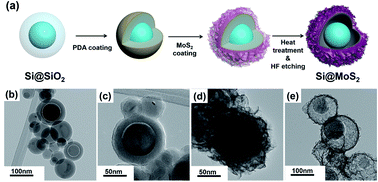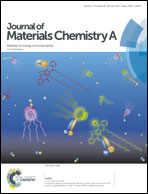Porous MoS2@C heteroshell with a Si yolk structure with improved lithium transport properties and superior cycle stability†
Abstract
To solve the problems of the Si anode such as excessive volume expansion and the corresponding destruction of the solid electrolyte interface (SEI) film, we propose a porous MoS2@C heteroshell with a Si yolk structure. We prepared a porous MoS2@C heteroshell with a Si yolk structure using polydopamine (PDA) polymerization and a hydrothermal method using sodium molybdate and L-cysteine. In particular, the PDA layer on the Si yolk plays a role as a medium in growing the MoS2 shell as a MoS2@C heteroshell. We proposed Si@C@MoS2 (SCM) structures having different MoS2 shell thicknesses (SCM1, SCM3, SCM5 in the order of shell thickness) and measured various electrochemical properties. When the MoS2 shell was thin (SCM1), it exhibited a high specific capacity of 1451 mA h g−1 with a coulombic efficiency of 86.6% after 100 cycles at a current density of 100 mA g−1 (1st cycle), 200 mA g−1 (2nd cycle), and 500 mA g−1 (3rd cycle and following cycles). Furthermore, it shows excellent rate capability even at high current density compared to the Si@C electrode. When the MoS2 shell was thick (SCM5), ultrahigh electrochemical output properties and rate capability were exhibited although it shows low absolute capacity because of the high MoS2 weight ratio. From the results, we found that the thin MoS2 coating on the carbon shell had advantages compared to only the carbon shell because of the remarkable Li ion transport properties of MoS2. It was also found that there is a trade-off between the MoS2@C heteroshell thickness and the participation of Si in electrochemical reactions. In addition, the initial coulombic efficiency depended on the MoS2 shell thickness. This excellent electrochemical phenomenon was attributed to the high specific surface area and high ion conductivity of MoS2. Therefore, it is expected that these phenomena can also be applied to other anode materials to enable excellent cyclic stability and good rate capability for high performance Li ion batteries.



 Please wait while we load your content...
Please wait while we load your content...